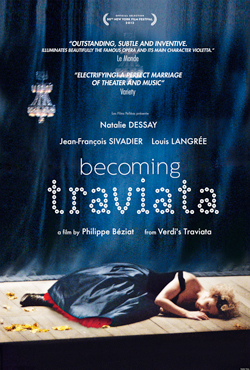by Timothy Robson

The film follows director Jean-François Sivadier as he prepares a production of the Verdi classic starring French soprano Natalie Dessay as Violetta Valery and American tenor Charles Castronovo as Alfredo Germont. French baritone Ludovic Tezier plays the pivotal role of Alfredo’s father Giorgio Germont. Louis Langrée was the conductor for the production, made for the 2011 Aix-en-Provence Festival in France.
From the beginning, there are the challenges of working language, with French and American principals, a British orchestra (the London Symphony) and an Estonian chorus. It is fascinating to watch Sivadier switch seamlessly between French, English and Italian, sometimes a sentence at a time.
The film brilliantly layers and interweaves the plot of the opera into the rehearsal process. At the beginning, Sivadier is working in a mostly bare rehearsal room with Dessay, Castronovo and piano accompaniment, charting the movement and drama of the opera’s opening party scene, almost phrase by phrase. Dessay is known as a brilliant operatic actress who clearly has ideas of her own, but she submerges her own ego to try the ideas of the director, sometimes with multiple possibilities, before they settle on the best solution. There are a few straight-back chairs as scenery.
As the plot of the opera progresses, the film in parallel shows later stages of the rehearsal process: orchestral rehearsal; the Sitzprobe, in which the singers and orchestra rehearse together for the first time; piano rehearsals on the Aix-en-Provence stage itself with more scenery; through what seems to be a late dress rehearsal with costumes, scenery, make-up and orchestra. The film director combines camera work and audio—music and rehearsal and performance—with a dream-like fluidity that is perhaps disorienting to someone not familiar with La Traviata. The attention is focused on Dessay; the tall, dark and handsome Charles Castronovo plays a significantly lesser role in the preparation (at least as much as we are shown). Ludovic Tezier, as Germont père, gives the distinct impression of being bored and annoyed by director Sivadier’s instructions. Louis Langrée is in many ways an equal partner to Sivadier, playing a similarly impressive part in giving instructions to the soloists, chorus and orchestra, often using simple metaphors to achieve his musical ends.
The opera production itself is starkly minimal, divorced from the nineteenth century, timeless but simultaneously contemporary, with the straight-back chairs (no magnificent bed for Violetta to die in; she lies on a pallet on the floor), and some painted hanging drop pieces depicting blue skies and clouds, and meadow fields. The costumes might be described as post-modern or post-punk. At Flora’s party in the second scene of Act 2, Dessay is clad in a royal blue gown, gathered at the waist, with visible red petticoat beneath. The third act begins almost where the second left off, with Violetta still in her party dress, but considerably more disheveled, with teased-out hair looking like Phyllis Diller on a bad day.
Her servant Anina helps her out of the gown; Violetta is left in a simple beige shift, close to death. Anina wipes Violetta’s face, but we discover that the maid has applied pale make-up, a stunning theatrical device finally showing Violetta with a death-like pallor. Jean-François Sivadier works at length with Dessay on just the right way for her to drop dead at the end of the opera. Indeed, as the final credits roll, we see Dessay working with a female assistant director to perfect just the right way to fall to the floor. There are at least twenty tries cut together one after another. The effect is comical, but shows Dessay’s dedication to perfecting her portrayal of the Parisian courtesan Violetta.
The DVD/Blu-Ray of Becoming Traviata is expected to be released in the U.S. in November; a DVD of the operatic production itself is already available on the Erato label via Amazon and other outlets. It will be worth seeing if for no other reason than as a recorded document of Natalie Dessay’s remarkable performance as Violetta Valery.
Published on ClevelandClassical.com September 10, 2013
Click here for a printable version of this article.



